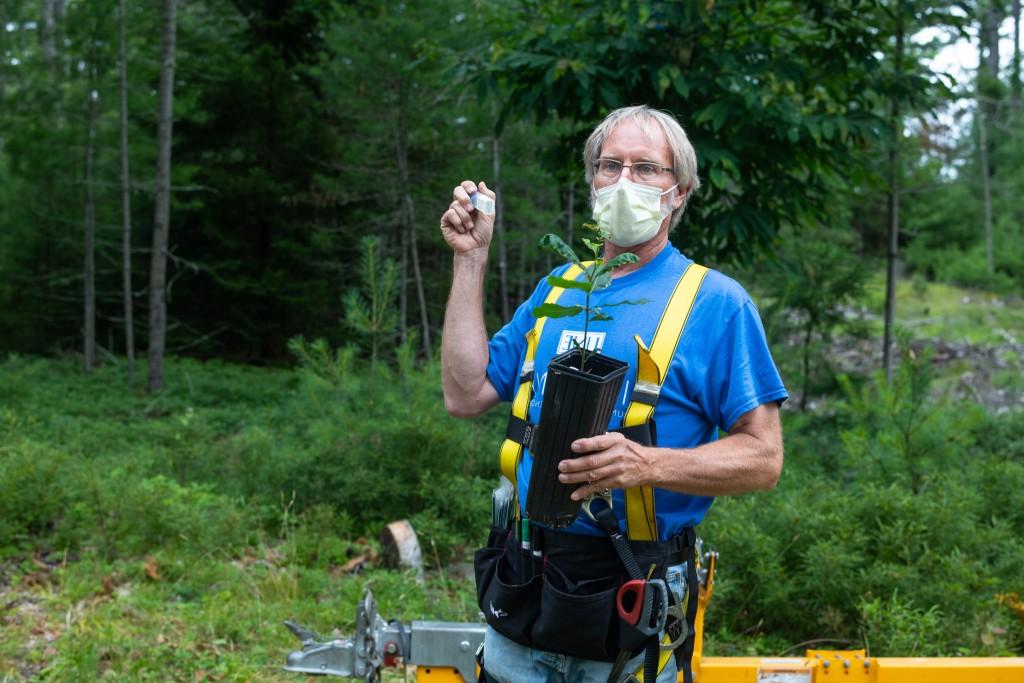The American chestnut: Restoring a keystone species

在伊丽莎白角的树林里, not far from where the land meets the sea, 托马斯·克拉克找到了涅槃. 那块地, 沿着一条土路, contains a national treasure — a rare collection of still-living American chestnut trees, most of them slowly dying of fungal blight, which Klak hopes to breed for restoration.
几个月来,克拉克博士.D.他是 环境研究 在正规澳门赌场网络任教, has worked with his students to speed-breed seedlings of the American chestnut, once so prominent in the Eastern United States that it was dubbed the “redwood of the East.”
But the trees have been decimated over the last century by a fungal blight accidentally imported from Asia. 寄生真菌引起可见, sunken cankers along the trees’ trunks and spreads toxic compounds into their living layers. Trees dying from blight can be seen expiring from the top down as they try to bring resources up from their roots, only to have their circulation cut off by the blight cankers.
在总, more than 3 billion of the keystone species have been wiped out since the blight was first detected in the early 1900s, but Klak and his students are working hard to reverse the destruction.
Their seedlings have been cross-bred with a gene from wheat that allows them to tolerate the fungal blight. It is a gene that is present in many wild plants, 包括草和苔藓, and in foods like bananas and strawberries.
It is a unique solution to a persistent problem. UNE is among the few colleges and universities across the country that have the blight-tolerant seedlings, and it is the only institution in New England where students are working with them. 一份来自美国的特别许可证.S. Department of Agriculture (USDA) allows UNE to grow the seedlings to produce the blight-tolerant pollen.
和, 在周五, 7月17日, 经美国农业部许可, the team pollinated the first wild chestnut trees with their blight-tolerant pollen — the first time the work had been done in Maine.
使用液压升降机, soaring 50 feet into the air to the treetops, Klak and his crew delicately tipped some of the pollen onto the flowers of the chestnut trees. They placed paper and wire bags over each flower cluster to prevent pollen from other wild trees from entering them (and to protect the seeds from ravenous squirrels).
The work had been planned for some time, though Klak’s current students were not able to partake in the pollination due to the novel coronavirus pandemic. But joining Klak was Flynn Willsea ’19 (环境科学),阿尔伯特·浮士德(Albert Faust) Maine chapter of the American Chestnut Foundation (ACF), and Larry Totten, a Maine chapter board member.
Willsea worked with Klak as a UNE student and was one of the first students to become involved in the chestnut restoration project. 在那段时间里, he helped tend to the seedlings in Klak’s greenhouse in the Harold Alfond Center for 健康 科学s.
“I'm very glad that I've been able to see this restoration project go all the way through, from first seeing a presentation in class and then getting out here and actually going up in the lift and pollinating the trees,威尔西说. “It's pretty amazing to see it come full circle.”
If the seedlings can restore the American chestnut, Klak说, it would be the greatest comeback of any tree species in North American history.
“The American chestnut used to be the most important tree of our Eastern forests,克拉克说。, who is vice-president of the Maine ACF chapter. “What we are seeing right now is a major breakthrough and step forward in chestnut restoration in Maine.”


